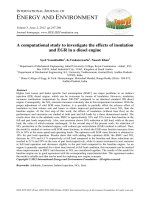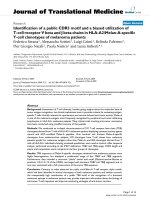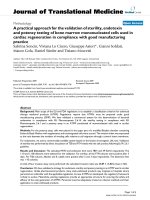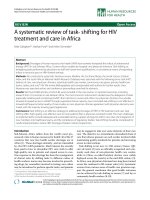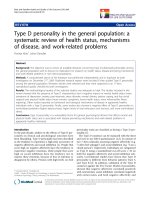Introducing Timepix2, a frame-based pixel detector readout ASIC measuring energy deposition and arrival time
Bạn đang xem bản rút gọn của tài liệu. Xem và tải ngay bản đầy đủ của tài liệu tại đây (6.29 MB, 8 trang )
Radiation Measurements 131 (2020) 106230
Contents lists available at ScienceDirect
Radiation Measurements
journal homepage: />
Review
Introducing Timepix2, a frame-based pixel detector readout ASIC
measuring energy deposition and arrival time
W.S. Wong a, *, 1, J. Alozy b, R. Ballabriga b, M. Campbell b, I. Kremastiotis b, X. Llopart b,
T. Poikela b, V. Sriskaran b, L. Tlustos b, c, d, D. Turecek d, e, f
a
Dept for Nuclear and Particle Physics, University of Geneva, Geneva, Switzerland
Microelectronics Section, CERN, Geneva, Switzerland
FMF, Albert-Ludwigs-University of Freiburg, Freiburg, Germany
d
University of Houston, Houston, TX, USA
e
ADVACAM s.r.o., Prague, Czech Republic
f
CAPI, First Faculty of Medicine, Charles University, Prague, Czech Republic
b
c
A R T I C L E I N F O
A B S T R A C T
Keywords:
particle energy deposition
Arrival time
Adaptive gain
Frame readout
The Timepix2 ASIC (application-specific integrated circuit) is the upgraded successor to the Timepix [1] hybrid
pixel detector readout chip. Like the original, Timepix2 contains a matrix of 65k square pixels of 55 μm pitch that
can be coupled to a similarly segmented semiconductor sensor, or integrated in an ionising gas detector. The
pixels are programmable, with several operation modes and selectable counter depths (up to 18 bits for time-ofarrival, ToA, and up to 14 bits for time-over-threshold, ToT). In ToT and ToA mode, each pixel records the arrival
time and energy deposited by particles interacting with the corresponding sensor segment, with an optional
separation of timing resolution for ToT and ToA: down to 10 ns each. The gain of the frontend circuit can be
programmed to adapt to the quantity of energy deposited in the sensor, yielding a large dynamic range of 0.38
ke− to 950 ke− . The frontend noise in adaptive gain mode is 380 e− rms. The design also introduces some power
optimisation features to the Timepix portfolio, such as power masking on selectable parts of the pixel matrix.
With all pixels powered on, using 100 MHz for both ToT and ToA clock frequencies, and assuming a sparse
particle interaction with the pixels, the matrix is estimated to consume less than 900 mW based on simulation.
1. Introduction
The Timepix family of chips (Llopart et al., 2007; Poikela et al.,
2014) is a spinoff of the Medipix hybrid pixel detector development.
Whereas the Medipix (Llopart et al., 2002; Campbell et al., 2018) chipset
targets medical imaging and other photon (or particle) counting appli
cations, the Timepix chips are intended for particle detection, in appli
cations such as the characterisation of radiation in space. The original
Timepix (Llopart et al., 2007) application-specific integrated circuit
(ASIC), released in 2006 by the Medipix2 Collaboration (Llopart et al.,
2002), contains 256 columns by 256 rows of square pixels of 55 μm pixel
pitch that can be programmed to either record the time-of-arrival (ToA)
or the energy deposition (time-over-threshold, ToT) of a particle
interaction in the sensor. Data from the chip is formatted in frames of
uncompressed data from all 65k pixels, including pixels that did not
record any particle interactions during the open shutter period. A
readout deadtime results from the pausing of measurement during the
readout of each frame. Following the successful use of Timepix in a
variety of applications (Ballabriga et al., 2011), the Medipix3 Collabo
ration (Campbell et al., 2018) released the Timepix32 ASIC in 2014
(Poikela et al., 2014). Unlike Timepix, where readout is frame-based,
data from Timepix3 is data-driven, whereby data is pushed off-chip as
soon as a measurement is completed in each pixel. The Timepix3 data
format includes the pixel address and both the ToA and ToT of the same
particle interaction in the associated pixel sensor segment. The
data-driven method permits long open shutter periods (because the pixel
* Corresponding author.
E-mail address: (W.S. Wong).
1
The first author designed the chip while at CERN, but is now at University of Geneva.
2
Chronologically, Timepix3 predates Timepix2. The naming convention refers to the fact that the Timepix3 chip was developed by the Medipix3 Collaboration,
whereas both Timepix and Timepix2 are from the Medipix2 Collaboration.
/>Received 15 January 2019; Accepted 7 December 2019
Available online 14 December 2019
1350-4487/© 2019 The Author(s). Published by Elsevier Ltd. This is an open access article under the CC BY license ( />
W.S. Wong et al.
Radiation Measurements 131 (2020) 106230
Fig. 1. Main pixel circuit blocks in regular operation.
storage elements are emptied and ready to characterise the next particle
interaction almost immediately) and avoids the reading out of empty
pixels. However, the data-driven file format also necessitates extra effort
to sort and reformat the data off-chip. This work introduces the Time
pix2 chip, developed by the Medipix2 Collaboration, which is intended
to be a frame-based successor of the original Timepix.
The Timepix2 chip was developed in a commercial 130 nm deep submicron technology process. It contains 256 columns by 256 rows of
square pixels of 55 μm pixel pitch. Data from the pixel matrix is typically
output in full frames via either a 100 Mbps serial port or a 3.2 Gbps
parallel bus. As a compromise between full-frame and data-driven
readout schemes, an optional zero-column-suppression readout mode
suppresses the readout of empty pixel columns when data is output from
the serial port. Multiple chips integrated in a common system can be
daisy-chained for readout and programming. Individual pixel power
masking optimises power consumption to permit region of interest
measurements, or to power down unused pixel electronics in hybrid
pixel detectors where only a subset of pixels in the ASIC are bumpbonded to a sensor with an increased pixel pitch (e.g. of 110 μm). An
optional matrix occupancy monitor flags the moment when the number
of pixel columns with recorded hits has surpassed a programmed
threshold of occupied columns. A set of digital pixels that contain the
same digital functionality as regular pixels but without the analogue
frontend, can be used to process discriminated signals from off-chip,
allowing for coincidence measurements with external instruments.
The wirebond pads at the bottom of the chip periphery are compatible
with through-silicon-via chip-to-board interconnect technologies.
Each pixel in the regular matrix consists of an analogue frontend with
an adaptive-gain preamplifier whose output is digitised by an energythreshold discriminator. The digital half of the pixel circuitry contains
state machines that select detected events, and counters that record ToT,
ToA and/or the tally of particle hits. Although Timepix2 is a highly
programmable, general-purpose detector chip, many of the design
choices target the requirements of operation in mixed radiation fields
with highly energetic particles, such as in space (Kroupa et al., 2015;
Gohl et al., 2016). The feature upgrades of the Timepix2 pixels include
simultaneous ToA and ToT measurement, separate ToA and ToT clock
frequencies, monotonic behaviour in ToT even for high input charges,
low minimum detectable energy due to low threshold dispersion,
increased overall dynamic range (both analogue and digital), high en
ergy resolution due to low frontend noise, fast clearing of data memory
on the matrix, per pixel power masking, the ability to both program and
read back individual pixel configuration settings, and separated
analogue and digital calibration options with programmable test charge
injection for the analogue frontend and digital test pulses for the digital
state machines.
2. The pixel matrix
The Timepix2 ASIC architecture consists of a main matrix of 256
columns of 256 rows of 55 μm-pitch square pixels, and a chip periphery
section containing global chip programming blocks, digital to analogue
bias circuits, and readout blocks. The main matrix is the active area of
the detector, where the pixel electronics are designed to be bumpbonded to a semiconductor sensor, such as a silicon pn junction diode
segmented into pixels. All pixels in the matrix feature identical func
tions. The block diagram of Fig. 1 shows that a pixel consists of an
analogue frontend followed by digital circuits that digitise and store the
particle measurement for readout. An electronic shutter signal de
termines the period of measurement.
Energy deposited in a sensor segment from a charged particle in
duces a signal in the corresponding frontend input on the ASIC. The
discriminator outputs a voltage pulse whose width is proportional to the
energy deposition. Thus a measurement of the ToT provides a digital
measurement of the energy absorbed in the sensor segment. Given that
the Timepix2 pixel side-length is only 55 μm, a highly energetic charged
particle, such as a heavy ion in space, will likely interact with multiple
pixels, depositing energy in a cluster of pixels. In a mixed radiation field,
the radiation species of the detected particle can be classified through
the morphology and energy deposited in the pixel cluster (Kroupa et al.,
2015; Gohl et al., 2016). As clusters from multiple particles can some
times overlap pixels, recording the ToA to complement the ToT energy
measurement would permit the correct association of data with different
detected particle interactions.
2.1. Adaptive-gain analogue frontend
The analogue frontend consists of a Krummenacher-type (Krumme
nacher, 1991) charge sensitive preamplifier (CSA) with adaptive gain,
followed by a threshold voltage discriminator. The CSA compensates for
leakage current from the sensor and can be programmed to process
either positive or negative polarity signals from the sensor material.
Each pixel also has a 5-bit digital to analogue converter that trims the
local threshold of the discriminator. A programmable control charge can
be injected to the input of the preamplifier during test and calibration of
the analogue frontend.
Whereas the gain of the CSA, which is inversely proportional to the
feedback capacitance, was a fixed value in previous Medipix and
Timepix ASICs, the Timepix2 frontend includes an adaptive gain scheme
based on a design which was originally developed for free electron laser
instrumentation (Manghisoni et al., 2015). Fig. 1 shows the parallel
paths for the feedback capacitance in the CSA: one path consisting of a
fixed capacitance between metal plates and a second path consisting of a
metal-oxide-semiconductor (MOS) capacitance. When the MOS capac
itor path is disabled, the CSA feedback capacitance, CFB, is based on the
2
W.S. Wong et al.
Radiation Measurements 131 (2020) 106230
Fig. 2. Simulations of the frontend behaviour in hole collection mode.
of Table 2. The digital pixels do not have an analogue frontend and are
not connected to the sensor; they are intended to process thresholddiscriminated inputs from external instruments.
Table 1
Parameters of the analogue frontend (values based on simulation).
Parameter
Fixed Gain
Mode
Adaptive Gain Mode (hole collection
only)
Minimum
threshold
Noise
Gain
Power
consumption
400 e-
380 e-
2.3. Event selection
In the operation modes that measure ToT (Modes 1–4 of Table 2), the
selection of events that contribute to the measurement is handled
differently by Timepix2 compared to its predecessor. In the original
Timepix, ToT is processed for all portions of discriminator output pulses
that occur within the open shutter period. Timepix2, on the other hand,
has the option to process just the first hit, or to integrate the ToT of all
hits that start within the open shutter period. In order to correctly
measure the charge deposited in high linear energy transfer (LET)
events, if a valid discriminator output pulse is still active by the time the
shutter closes, the ToT count continues until the end of the event, or
until the counter saturates. Fig. 3 depicts the selection of events for
processing in the main operation modes. Separate clocks are used for
ToT and ToA counting. In the simultaneous ToT and ToA modes (Modes
1–2), the open shutter period is defined as the period during which the
shutter is low. In the continuous read/write modes (Modes 3–8), the
shutter signal becomes a counter select.
60 e− rms
50 e− rms
25 mV/ke19 mV/ke− (for low input charges)
5 μA/frontend @1.2 V
metal plate capacitance and the CSA gain is constant for all input charge
values. When the MOS capacitor is enabled, CFB is the combination of
the metal plate and the MOS capacitance, which is biased by the CSA
input. In adaptive gain mode, the gain is high with low input charges and
low with high input charges. Even when the input charge versus pulse
height relationship becomes logarithmic, simulations show that the ToT
of the discriminator output pulse increases monotonically with input
charge up to 950 ke− ; the ToT is expected to plateau at a maximum value
beyond this point. Fig. 2 shows simulations of the frontend behaviour
with and without adaptive gain (AG). Best case (CBEST) and worst case
(CWORST) refer to minimum and maximum extracted CFB values, and
LP denotes the use of low power (i.e. high threshold voltage) transistors.
The ToT values on these plots are derived from transient simulations of
the CSA output prior to threshold discrimination; the “threshold” used
here is an ideal threshold voltage. Due to the preamplifier topology, the
adaptive gain mode is only compatible with sensors that provide posi
tive polarity signals. Table 1 lists the design parameters of the Timepix2
analogue frontend based on simulation.
2.4. Pixel power optimisation
Although all pixels are functionally identical, they were grouped in
“superpixels” of 2 × 16 pixels during synthesis, place and route, in order
to optimise the sharing of resources. Clock trees are generated and gated
at the superpixel level to reduce digital power consumption if no hits are
detected within the local superpixel. This type of power optimisation
targets particle detection applications with sparse data in the pixel
matrix. Operating in the simultaneous ToT and ToA mode, with both
ToT and ToA clocks running at the maximum 100 MHz frequency, and
assuming sparse hits, the pixel matrix is estimated to consume <500 mW
digitally. Combined with the current consumption of the analogue
frontend, the estimated total power consumption in the full pixel matrix
is < 900 mW, based on simulation reports.
2.2. Digital modes
The digital part of the pixel processes the threshold-discriminated
output from the analogue frontend. Each pixel contains a total of 28
bits that can be chained together to form 4-bit, 10-bit, 14-bit, or 18-bit
counters that record ToT, ToA or number of particle hits. Table 2 lists
the various operation modes. In the simultaneous ToT and ToA modes
(Modes 1–2), the counter chains count concurrently and the pixels pause
measurement during readout (i.e. the reading and writing operations are
sequential). In the continuous read/write modes (Modes 3–8), the two
counter chains are identical in depth and alternate between counting
and reading modes, such that there is no readout deadtime. Existing data
in the counters can be quickly discarded with a fast clear command
without the need to read out the counters. A programmable digital test
pulse can be sent to selected pixels for digital test and calibration in
dependent of the analogue frontend. In addition to the eight operation
modes of Table 2, Table 3 lists the modes for programming and digital
diagnostics of pixel memory.
A set of digital pixels in the chip periphery also operate in the modes
2.5. Power masking
While all Medipix and Timepix ASICs include the capability to mask
the digital functionality of individual pixels, the pixel circuits in the
Timepix2 chip are also powered down when masked. On the digital side,
the measurement reference clock is gated with the pixel mask bit to turn
off dynamic power consumption. On the analogue side, the discrimi
nator is powered down completely, while the preamplifier is supplied
with a minimal current (a few nA versus the nominal several μA) to
maintain sensor leakage current compensation. This scheme permits
partial activation of regions of interest in the matrix without
3
W.S. Wong et al.
Radiation Measurements 131 (2020) 106230
Table 2
Digital operation modes.
Mode
Mode1
Mode2
Mode3
Mode4
Mode5
Mode6
Mode7
Mode8
Description
a
Simultaneous ToT & 1st hit ToA
(sequential read/write)
User-defined options:
1) 1st hit or integral ToT
2) ToT clock frequency
3) ToA clock frequency
4) Wraparound of ToA counter
Continuous read/write ToT
with optional event counting
User-defined options:
1) 1st hit or integral ToT
2) ToT clock frequency
Continuous read/write ToT
User-defined options:
1) 1st hit or integral ToT
2) ToT clock frequency
Continuous read/write ToA
User-defined option:
ToA clock frequency
Continuous read/write
event counting
User-defined option:
Counter1
Counter2
Counter3
Counter4
10-bit ToT
14-bit ToT
18-bit ToA
14-bit ToA
n/a
n/a
n/a
n/a
10-bit ToT
10-bit ToT
4-bit #events
(paired with Counter1)
4-bit #events
(paired with Counter2)
14-bit ToT
14-bit ToT
n/a
n/a
10-bit ToA
14-bit ToA
10-bit ToA
14-bit ToA
n/a
n/a
n/a
n/a
10-bit #events
14-bit #events
10-bit #events
14-bit #events
n/a
n/a
n/a
n/a
Reference clock frequency
a
Since the ToA counter of a pixel can only store the timestamp of one event, it records the arrival time of the first event to occur within the open shutter period,
regardless of whether the ToT option is programmed to evaluate 1st hit ToT or integral ToT.
unnecessarily consuming power in the unused regions. The time to
power down or re-activate pixels in the matrix is the time it takes to
reprogram the configuration bits: 2.6 ms.
4.1. Data acquisition system
The measurements presented here were obtained with a Timepix2
hybrid pixel detector (Fig. 4a), mounted on a custom Timepix2 chip
board (Fig. 4b), connected to an AdvaDAQ data acquisition system and
controlled by PiXet software (Turecek et al., 2016). The chipboard can
be cut to permit the tiling of Timepix2 detectors mounted on separate
cards.3 It contains industry standard connectors, voltage regulators, a
power measurement chip, multiple test points, and a backside pulse
processing (BPP) circuit to correlate events in the pixel matrix with
events detected through the backside pulse in the sensor. The BPP circuit
comprises a charge sensitive preamplifier followed by a bandpass filter.
With the addition of a threshold discriminator to digitise the signal, the
BPP output can be fed back to a digital pixel on the Timepix2 ASIC for
ToT and ToA measurement. Since the BPP uses discrete components, the
dynamic range can be customised for a particular application. For
example, the choice of a CSA feedback capacitance of 1 pF would permit
the charge integration of up to 100 MeV, while a 10 pF feedback
capacitance would process up to 1 GeV in a silicon sensor.
3. Framerates
Data from the pixel matrix can be read out from a serial port or a 32bit parallel bus. Both serial and parallel ports operate at up to 100 MHz.
In regular full frame readout mode, data from all 65k pixels are output
from the chip, including data from empty pixels. An optional zerocolumn-suppression (ZCS) readout mode minimises the readout of
empty columns during output from the serial port. In ZCS mode, a 256bit column hit map register is first output, followed by data from the
columns enabled in the hit map. The architecture of the ZCS mode re
quires that a minimum of 16 columns be output (even if they are empty).
Table 4 lists the time to read a frame from the Timepix2 chip, using the
maximum data clock frequency of 100 MHz. In the simultaneous ToT
and ToA operation mode, the minimum readout deadtime corresponds
to tread of 28 bits. In the continuous read/write modes, there is no
readout deadtime, but the minimum counting period is defined by tread.
4.2. Basic diagnostics tests
4. Measurements
Digital diagnostics tests of the Timepix2 ASIC pass. We can write data
into, and read back from, global chip programming registers in the chip
periphery. We can also write and read back random patterns into all
storage elements in the pixel matrix, including individual pixel config
uration and trim latches, and the data counters. ToT, ToA and event
counting using both analogue and digital test pulses function correctly.
In this work, we report some preliminary measurements to demon
strate the most quickly testable features of the Timepix2 ASIC.
Table 3
Digital programming and diagnostics modes.
Mode
Description
Mode9
Mode10
Mode11
Mode12
Set individual pixel configuration settings
Get individual pixel configuration settings
Set individual pixel threshold trim codes
Get individual pixel threshold trim codes
3
Multiple Timepix2 detectors can be tiled to create a larger combined active
area. The detectors can be abutted along three edges with ~60 μm dead area
between chips.
4
W.S. Wong et al.
Radiation Measurements 131 (2020) 106230
Fig. 3. Event selection with respect to the shutter state.
4.4. Preamplifier response to test charge injection
Table 4
Time to output frames in Timepix2, assuming 100 MHz clock.
#
bits/
pixel
Full frame,
serial port
Full frame,
parallel port
ZCSa,
serial port
tread
[ms]
framerate
[fps]
tread
[ms]
framerate
[fps]
tread
[ms]
framerate
[fps]
4
10
14
28
2.62
6.55
9.18
18.35
381
153
109
54
0.08
0.20
0.29
0.57
12207
4883
3488
1744
0.16
0.41
0.57
1.15
6104
2441
1744
872
For testing purposes, the output of the CSAs in the bottom row of the
pixel matrix can be buffered and monitored by a test point on the
chipboard. Fig. 6 shows screen captures of an oscilloscope monitoring
the CSA output of a sample pixel stimulated by the injection of a test
charge. The quantity of test charge is estimated based on the test
capacitance value, Ctest, which is extracted to be 5.8 fF by circuit
simulation tools. In fixed gain mode (images on the left), the CSA output
pulse height increases linearly with input charge quantity until the CSA
output pulse height saturates. In adaptive gain mode (images on the
right), the frontend gain is at a maximum for low quantities of input
charge, and decreases as higher input charges turn on the MOS capacitor
(Fig. 6c). The gains labelled on Fig. 6 are approximations based on the
CSA output pulse height estimated from the oscilloscope screen shot. A
precise gain calculation would require more detailed measurements.
Nevertheless, the gains obtained from these preliminary tests indicate
that the actual gain of the circuit agrees reasonably well with the value
expected from simulation, listed in Table 1.
a
The readout time and framerate in ZCS mode depends on the number of
columns that contain data. The values shown in Table 4 are based on 16 col
umns, which is the minimum number of columns that must be read out in ZCS
mode.
4.3. DAC scans
Fig. 5 shows input parameter sweeps of the digital to analogue
converters (DAC) that are located in the chip periphery and provide
programmable biasing of the analogue circuits. The DAC outputs agree
with expected values.
4.5. ToT measurement of analogue test charge
Fig. 7 shows ToT measurements of controlled test charges injected
into the analogue frontend. Each data point represents the ToT counter
Fig. 4. Timepix2 with silicon sensor mounted on the chipboard. (For interpretation of the references to colour in this figure legend, the reader is referred to the Web
version of this article.)
5
W.S. Wong et al.
Radiation Measurements 131 (2020) 106230
Fig. 5. DAC scans.
Fig. 6. Test charge injection to CSA, in fixed and adaptive gain modes.
value in a single pixel after ten consecutive analogue test pulses during
the open shutter period. In Fig. 7a, a linear fit of the two curves in the
region between 5 ke− to 30 ke− shows that the slope of the integral ToT
(iToT) counts is 9.97 times the slope of the 1st hit ToT counts. Allowing
for frontend noise and ToT quantisation error, this preliminary result
suggests that the pixel correctly processes the ToT of only one out of ten
test pulses in 1st hit ToT mode, and measures the cumulative ToT of all
ten test pulses in iToT mode. Fig. 7b shows the 1st hit ToT measurement
with and without adaptive gain (AG) in the analogue frontend. Turning
on AG does not seem to introduce any obvious non-linear effects to the
ToT versus input charge relationship. The offset in the minimum
detected input charge between these two uncalibrated measurements is
6
W.S. Wong et al.
Radiation Measurements 131 (2020) 106230
Fig. 7. Measurements of test charge injected at the input of the preamplifier.
Fig. 8. Simultaneous ToT and ToA measurement in a mixed radiation field.
due to the difference in frontend gain in the two modes (see Table 1).
energy in a cluster of pixels in a “blob” shape (e.g. Fig. 8, shape A), beta
electrons interact with a cluster of pixels in a snake-like “squiggle” (e.g.
Fig. 8, shape B), and gammas interact with single (or a very small cluster
of two to four) pixels (e.g. Fig. 8, shapes C). The ToA timestamp helps to
identify clusters resulting from the same radiation interaction, and to
distinguish between spatially overlapping clusters.
It should be noted that the data in Fig. 8 were taken with an uncal
ibrated detector for demonstration purposes. A proper characterisation
of the radiation field would require data from a calibrated detector. A
calibration technique to map ToT counts to energy deposited in each
pixel is described in detail in (Jakubek, 2011).
4.6. Simultaneous ToT and ToA measurements with radiation sources
Fig. 8 shows a frame output from a Timepix2 ASIC bump-bonded to a
500 μm p-on-n silicon sensor, displaying the energy and timestamp
simultaneously measured within the same open shutter period. The chip
was programmed to operate in the simultaneous ToT and ToA mode,
with a 10-bit ToT counter and an 18-bit ToA counter per pixel. The
Timepix hybrid pixel detector was exposed to a mixed field of beta
electrons from a Sr90 source, alpha particles from an Am241 source, and
gamma photons from the same Am241 source. Typically alphas deposit
7
W.S. Wong et al.
Radiation Measurements 131 (2020) 106230
5. Conclusions and future work
Campbell, M., Ballabriga, R., Llopart, X., 2018. Asic developments for radiation imaging
applications: the medipix and timepix family. Nucl. Instrum. Methods Phys. Res.
878, 10–23. />Gohl, S., Bergmann, B., Granja, C., Owens, A., Pichotka, M., Pospisil, S., 2016.
Measurement of particle directions in low earth orbit with a Timepix. J. Instrum. 11,
C11023. />Jakubek, J., 2011. Precise energy calibration of pixel detector working in time-overthreshold mode. Nucl. Instrum. Methods Phys. Res. 633, S262–S266. https://doi.
org/10.1016/j.nima.2010.06.183.
Kroupa, M., Bahadori, A., Campbell-ricketts, T., Empl, A., Minh, S., Idarraga-munoz, J.,
Rios, R., Semones, E., Stoffle, N., Tlustos, L., Turecek, D., Pinsky, L., 2015.
A semiconductor radiation imaging pixel detector for space radiation dosimetry. Life
Sci. Space Res. 6, 69–78. />Krummenacher, F., 1991. Pixel detectors with local intelligence: an IC designer point of
view. Nucl. Instrum. Methods Phys. Res. 305, 527–532. />0168-9002(91)90152-G.
Llopart, X., Campbell, M., Dinapoli, R., San Segundo, D., Pernigotti, E., 2002. Medipix2: a
64k pixel readout chip with 55-um square elements working in single photon
counting mode. IEEE Trans. Nucl. Sci. 49 (I), 2279–2283. />TNS.2002.803788.
Llopart, X., Ballabriga, R., Campbell, M., Tlustos, L., Wong, W., 2007. Timepix, a 65k
programmable pixel readout chip for arrival time, energy and/or photon counting
measurements. Nucl. Instrum. Methods Phys. Res. 581, 485–494. />10.1016/j.nima.2007.08.079.
Manghisoni, M., Comotti, D., Gaioni, L., Ratti, L., Re, V., 2015. Dynamic compression of
the signal in a charge sensitive amplifier: from concept to design. IEEE Trans. Nucl.
Sci. 62 (5), 2318–2326. />Poikela, T., Plosila, J., Westerlund, T., Campbell, M., De Gaspari, M., Llopart, X.,
Gromov, V., Kluit, R., van Beuzekom, M., Zappon, F., Zivkovic, V., Brezina, C.,
Desch, K., Fu, Y., Kruth, A., 2014. Timepix3: a 65K channel hybrid pixel readout chip
with simultaneous ToA/ToT and sparse readout. J. Instrum. 9, C05013. https://doi.
org/10.1088/1748-0221/9/05/C05013.
Turecek, D., Jakubek, J., Soukup, P., 2016. USB 3.0 readout and time-walk correction
method for Timepix3 detector. J. Inst. Met. 11.
In this work, we have presented the Timepix2 hybrid pixel detector
readout ASIC. Timepix2 is a programmable detector intended for par
ticle physics applications requiring a compact, high-resolution detector
with high dynamic range. Several feature upgrades have been added
compared to its predecessor, including a selectable adaptive gain fron
tend, event selection based on the shutter state, simultaneous ToT and
ToA counting, separate ToT and ToA timing resolutions, continuous
read/write modes, pixel power masking, and matrix occupancy moni
toring. A custom chipboard has been designed and an AdvaDAQ data
acquisition system has been modified to read out the Timepix2 detector
for initial tests. Preliminary results indicate that all tested chip functions
perform correctly and agree well with expectations from simulations.
The results reported here were only preliminary tests obtained
within the first few weeks since the reception of the ASIC from the
foundry. A more comprehensive characterisation of the Timepix2 hybrid
pixel detector with various sensor types will follow. The development of
other data acquisition systems is also planned. The Timepix2 design
realises the many features requested by the members and partners of the
Medipix2 Collaboration, and we look forward to seeing the Timepix2
detector used in a variety of applications.
References
Ballabriga, R., Campbell, M., Heijne, E., Llopart, X., Tlustos, L., Wong, W., 2011.
Medipix3: a 64k pixel detector readout chip working in single photon counting mode
with improved spectrometric performance. Nucl. Instrum. Methods Phys. Res. 633,
S15–S18. />
8


